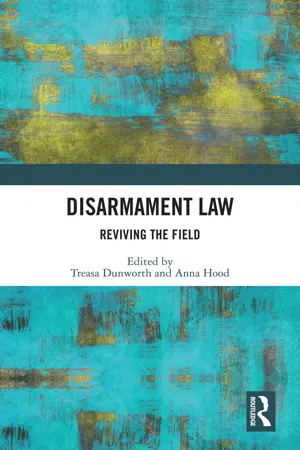I Reviving disarmament law
Law is a fundamental component of disarmament. There is a complex web of international treaties, Security Council resolutions and soft law instruments that address the threat posed by weapons, an array of international institutions that work to regulate and eliminate weapons, and a steady stream of disarmament law crises that get aired in the media on a regular basis. Despite all this, in recent decades, the field of disarmament law has received relatively little attention from academics. There is limited discussion or debate about key disarmament law issues, and many issues are not addressed at all in the academic literature.
The dearth of disarmament law scholarship stands in stark contrast to the wealth of scholarship that has emerged in other areas of international law over the last 30 years. Since the end of the Cold War, there has been a rich body of work produced about all manner of international legal topics including international trade law, international environmental law, international human rights law, international criminal law, international refugee law, international law of the sea, international humanitarian law, international economic law and the law of international organisations.
For a number of years, we have been concerned about the relative lack of academic work on disarmament law issues. In our view, there needs to be more doctrinal work that explores how disarmament laws operate and interact with one another as well as with other areas of international law. There are also considerable gaps in the conceptual scholarship on the values that underpin disarmament law, the trends and patterns that have emerged within it over time, and the blind spots that exist within it. Critical and theoretical scholarship as well would allow for identifying, questioning and challenging assumptions within the field and so perhaps lead to better understandings of the myriad dynamics at play in the disarmament law space.
We decided then, in 2017, to begin a project to make space for this scholarship. In making that space, we were mindful of the valuable, and still relevant, work of a host of academics in the first half of the 20th century as they turned their minds to disarmament law issues.1 Inspired by their work and mindful of the need to engage in more work explaining, developing, critiquing and theorising the body of disarmament law, we embarked on this project to revive disarmament law. The project had two elements. The first was to convene a conference on disarmament law, bringing together those scholars who were thinking about disarmament law issues to share their work, develop ideas and, in this way, begin building a community of disarmament law scholars. That conference was held in mid-2018 at Auckland Law School. The second element of our project was to produce an edited collection of the papers that were prepared for, and discussed at, the conference. Our hope was (and still is) that the edited collection would provide a snapshot of the ideas, concerns and issues that disarmament scholars were thinking about at the end of the second decade of the 21st century and provide a foundation upon which further scholarship could be built.
II Overview of the contributions
We were very fortunate to receive positive responses from across the globe and in June 2018 legal scholars from Austria, Australia, Germany, Hong Kong, Japan, New Zealand, South Africa, the United Kingdom and the United States gathered to share their research and ideas. The eight pieces in this book, which emerged from the conference,2 touch on a wide variety of disarmament law matters and provide a diverse range of views.
There are some synergies within the chapters that have allowed us to group them into three parts. Part I is entitled ‘Disarmament law research agendas’ and contains two chapters that look at broad trends and patterns in disarmament law. The first chapter is Treasa Dunworth’s. It surveys contemporary disarmament law work and shows how disarmament practitioners and academics have a tendency to respond to particular crises of disarmament, and how there is a a tendency to focus on disarmament law issues in silos. She terms this state of affairs the ‘crisis-silo’ dynamic and unpacks what the consequences of these dual preoccupations are for the field before laying out ideas for how the field could break out of this dynamic and adopt new approaches.
